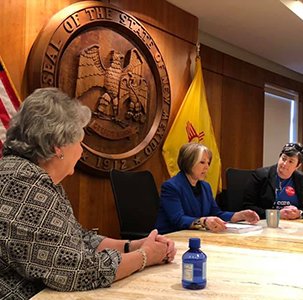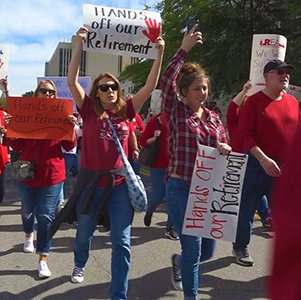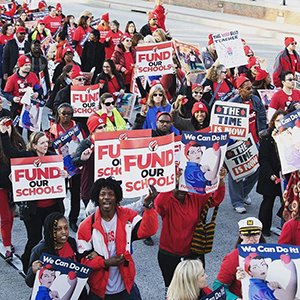The conversation about public education is changing in statehouses across the country. The assumption that schools must operate in austerity—and that struggling schools should be punished—no longer prevails.
After more than a decade of deep education cuts and lagging teacher salaries, a renewed commitment to public schools is emerging. What’s changed? Some states elected more pro-public education legislators in 2018. The #RedForEd movement, and a series of polls showing public support for increased investment in public schools and teacher pay, made new and veteran legislators alike take notice.
As always, these state legislative wins also required the ongoing work of dedicated NEA leaders and members asking state lawmakers to stand up for public education, and do away with systems that label and threaten public schools.
Here are a few of those victories:
New Mexico
Educators and parents fighting to strengthen public education in New Mexico set the stage for progress by electing Gov. Michelle Lujan Grisham and more pro-public education members to the state legislature. Only then could the failed policies of past administrations be changed during the 2019 legislative session. There were several enormous wins for public schools.
First, the legislature increased education funding by 16 percent, which will support an extended learning program of 10 student days and more educator professional development.

Legislators also increased the minimum teacher salary to $41,000 and raised salaries for all public school employees by an average 10 percent. Betty Patterson, president of National Education Association-New Mexico (NEA-NM), said the pay boosts will help schools “recruit and retain quality teachers and other education employees.”
Additionally, the legislature took steps to repeal the state’s A-F school grading system and expand the Community Schools Act. That means that instead of labeling schools as ‘failing’ and threatening to close them, the state will work to support struggling schools and recognize schools that are doing well or making progress.
NEA-NM Vice President Mary Parr-Sanchez, says working to meet community needs will lead to solutions to the most challenging obstacles in education. The goal is to stabilize communities with the right programs and resources so that students can focus on school. Gov. Lujan Grisham signed the act into law on April 3.
Get more details on 2019 wins for New Mexico’s public schools here.
The state is planning to launch a more thorough school assessment system, the New Mexico Spotlight Dashboard, this fall.
Arkansas
In some legislatures, the best offense is a good defense. This was the case in Arkansas, where bipartisanship and educator advocacy helped defeat a series of bills that would only hurt public schools and educators.
A critical victory for members of the Arkansas Education Association was the defeat of a voucher expansion bill. SB539 would have established a multi-million dollar voucher scheme to divert funds to private schools through the tax code. It offered corporations tax credits for donations to send students to private schools.

Some legislators also attempted to push votes on anti-union bills that would strip due process rights from teachers in takeover districts, and prohibit districts from deducting union membership dues directly from a teacher or classified employee’s salary. These are common ploys meant to debilitate worker unions.
AEA members worked hard to defeat these bills, meeting at the state Capitol building and contacting members on the committees responsible for the bills.
Maryland
Here’s the headline from Maryland’s 2019 legislative session: Over the next three years, education funding in Maryland will be increased by $1.1 billion.
It’s a spectacular accomplishment, one built over years of advocacy by Maryland State Education Association (MSEA) members and allies to improve public schools. First, education advocates pressed lawmakers in 2015 to order a study to establish the real cost of educating the state’s students. The Kirwan Commission Adequacy Study showed $2.9 billion in unmet needs annually in Maryland’s public schools. Educators were vocal participants at public hearings conducted in 2017 before the Kirwan Commission released its final recommendations.

Then, in 2018 MSEA members worked hard to pass Question 1, a statewide ballot question to ensure that casino revenues meant for schools would increase, rather than supplant, existing funding. The measure passed with 89 percent of the vote, making it the most successful ballot measure in more than two decades.
Around 8,500 educators rallied at the March for Our Schools on March 11, 2019, to encourage lawmakers to act. They did. The legislation they passed, the “Blueprint for Maryland’s Future,” raises teacher pay and implements programs to help low-income and special education students.
While celebrating the giant step forward, Cheryl Bost, Maryland State Education Association President asked educators to keep up the forward momentum, saying, “we can’t be satisfied until all of our schools, educators, and students have what they need to be successful.”
In the next legislative session that begins in January 2020, the General Assembly will review the state’s school funding formula, which determines how state funds are distributed.
Members are sustaining the momentum at local Red for Ed events while advocating for better contracts in their counties, and plan to keep it going with local organizing efforts in advance of the key 2020 session.



